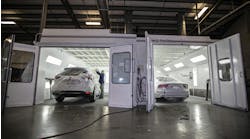Is your business in a rut? Is your shop failing to perform as well as you think it should and you’re at a loss about how to revive your slumping business?
Like this article? Sign up for our enews blasts here.
It’s a scenario I’ve seen a hundred times over the years. I’ve even worked with owners individually to help figure out why their shops are struggling. In every case, the one consistent factor is that the owner is failing to be the kind of leader that inspires, motivates and helps his or her shop grow.
That may sound harsh, but when you take a good hard look at your shop, ultimately, as the owner, you have to take responsibility for how the shop operates. Some owners blame the employees, a poor location, I’ve even heard some shop owners claim their shop is jinxed (seriously, jinxed).
If you’re in a rut, or if your shop isn’t growing as expected, there are three simple things you can do to show immediate results and improve sales.
Establish a Vision
In order to be successful, you have to set goals. But before you can set a goal, you have to understand what will be required to reach that goal and what, as an owner, you will need to do to follow up and motivate your team towards that goal.
Successful owners set realistic goals. But it goes much deeper than that. You need to involve your employees in goal setting. You need to have a plan that lays out how to reach those goals, and you have to participate every day to reach those goals.
It’s the same principle as losing weight. I recently lost 45 pounds by applying the same strategy as I do to my business. I set a goal that was specific and realistic (i.e. losing 50 pounds). I laid out a plan to reach that goal (following a better diet, starting an exercise regimen) and I measured my progress by weighing myself every day.
Simply stating that you’d like to increase sales by 20 percent isn’t enough. You need to outline the steps you’ll take to achieve that goal. Solicit feedback from your employees to determine where to make improvements and establish goals around those areas.
Increasing the number of oil changes you perform by 50 percent, having a faster turnaround time or growing customer count are all great goals. Notice that it’s not just about increasing sales. Each department in your shop should have different short and long-term goals. Your sales associates, technicians and management team should all understand what is expected of them and, more importantly, have a clear route to reach their goals.
By listening to your team, involving them in the goal-setting process and establishing rewards for reaching those goals, you’ll be creating a fun, competitive environment where the employees feel empowered and motivated.
Pull with a Rope
Some owners set goals and then push their team with a rope. You can’t push with a rope, you pull. In other words, you have to participate in meeting the goals you set. You need to work with the employees every day to make sure the team is moving forward. This can be as simple as hopping behind the front desk and working with customers. It can also mean seeking additional training for specific team members, implementing new processes or improving your own knowledge base.
Successful owners are always looking for ways to improve themselves, their teams or their shops. Even if the shop is consistently reaching goals, successful shop owners continue to find ways to involve employees by joining community groups, attending seminars and working side by side with their staff members.
Let’s face it; employees always think the shop owner is making more money than they really are. Be transparent with your employees. Show them the numbers and then ask them for solutions to cutting costs, increasing sales or improving customer service. When they see the numbers, your team will work with you and not against you. I share my performance figures as part of the training process and as a motivational tool, not as a way to punish employees.
Employees like to be part of something that is growing. When I had my first shop, I sat down with my staff and showed them the numbers we needed to reach in order to open a second shop. We then set goals around meeting those sales. They understood that expansion meant more opportunities for them, better equipment and updated systems. They didn’t do it alone, though. I was there every day, working with them, solving problems and serving customers. I was pulling the rope.
Measure the Results
There’s an old saying that numbers never lie. When you look at your bottom line, the numbers have a story to tell. The problem is, many shop owners aren’t reading that story. I look at my profit and loss report every day. That’s the only way to see if we are improving and moving towards meeting our goals.
Your daily reports will give you a clear picture of how your shop is running. Are the turnaround times improving? Is your spending under control? Are your sales meeting expectations? I check my reports to see if my shops’ benefits are being sold correctly. I look to see where our areas of strength are and where we need improvement. In essence, your profits and loss reports are just another way to evaluate how well you’re meeting your goals.
There are more ways to go out of business than there are ways to stay in business. If you’re doing everything right, and your shop is still struggling, then you might consider getting out of the business. Chances are, though, like most shop owners, there are things you can do to improve your bottom line.
You need to realize there is a problem first. That means taking a hard look at your shop, your processes and yourself. Find the areas that need improving and set goals to strengthen your areas of weakness.
If you can take the necessary steps, you’ll dig your way out of the rut and place your business on the path to success.
Have articles like this sent to you weekly by signing up for our enews blasts here.


